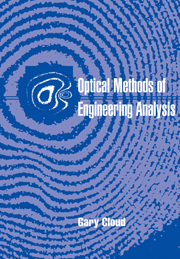Book contents
- Frontmatter
- Contents
- Acknowledgments
- 1 Introduction and orientation
- Part I Optics and interferometry
- Part II Photoelasticity
- Part III Geometrical moire
- Part IV Diffraction theory, optical processing, and moire
- 10 Diffraction and Fourier optics
- 11 Moire with diffraction and Fourier optical processing
- 12 Procedures of moire analysis with optical processing
- Part V Moire interferometry
- Part VI Holographic interferometry
- Part VII Speckle methods
- Author index
- Subject index
10 - Diffraction and Fourier optics
Published online by Cambridge University Press: 12 January 2010
- Frontmatter
- Contents
- Acknowledgments
- 1 Introduction and orientation
- Part I Optics and interferometry
- Part II Photoelasticity
- Part III Geometrical moire
- Part IV Diffraction theory, optical processing, and moire
- 10 Diffraction and Fourier optics
- 11 Moire with diffraction and Fourier optical processing
- 12 Procedures of moire analysis with optical processing
- Part V Moire interferometry
- Part VI Holographic interferometry
- Part VII Speckle methods
- Author index
- Subject index
Summary
The interference phenomenon and its place in optical measurement have, to this point, been the dominant themes. This chapter introduces and develops in detail the second anchor point in optics, diffraction by an aperture. After discussion of diffraction theory, several simple but important examples are presented; then the idea of optical spatial filtering is explained. These concepts are important in the remainder of the book.
Overview and problem identification
One of the oldest and most fundamentally important problems in optics is to predict the nature of the light field at any distance and direction from an illuminated aperture having arbitrary shape and perhaps containing certain optic elements in the form of a lens, a grating, or some kind of a filter. This problem is important because it provides an understanding of the formation of images by optical components, and it leads to ways of predicting, specifying, and measuring the performance of optical systems. Diffraction theory also leads to a conception of certain optical components as Fourier transforming devices, and it gives us the theoretical basis of whole-field optical data processing. The recording and analysis of moire gratings, the process of holography and holographic interferometry, and the methods of speckle interferometry and speckle photography all can be understood as diffraction processes.
The diffraction problem is complex and has not yet been solved in generality. The classic solutions rest on some severe assumptions that are not altogether realistic and logical. Even with the simplified solutions, the calculation of the optical field for arbitrary or complex apertures is forbidding. It testifies to the brilliance of the devisers of these solutions that their results describe and predict with considerable accuracy what is observed.
- Type
- Chapter
- Information
- Optical Methods of Engineering Analysis , pp. 195 - 225Publisher: Cambridge University PressPrint publication year: 1995

